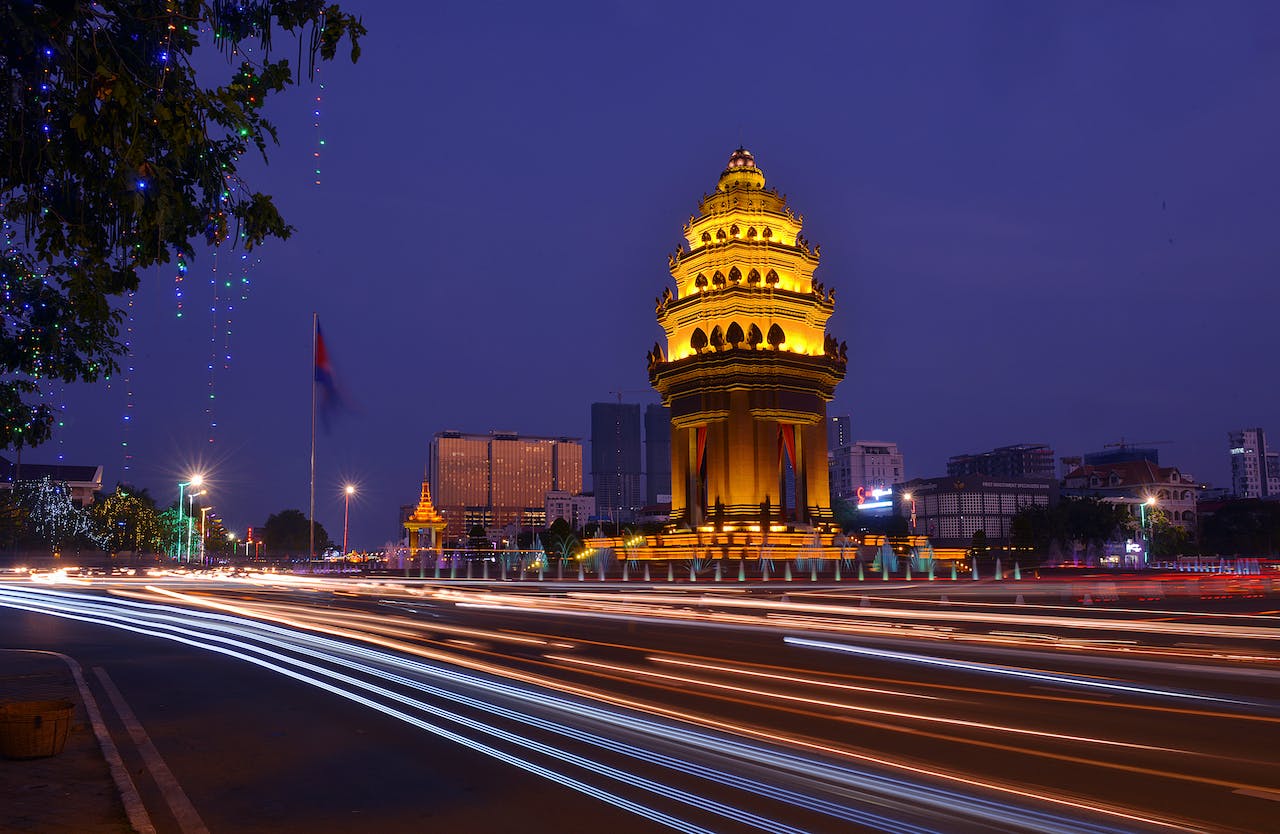The Angkor temples in Siem Reap, Cambodia, are one of the most significant archaeological sites in Southeast Asia and a UNESCO World Heritage Site. They are remnants of the ancient Khmer Empire, which once dominated much of Southeast Asia. Here are some key aspects of the Angkor temples:
- Historical Significance: The temples were built between the 9th and 15th centuries when the Khmer Empire was at its peak. They served as the empire’s spiritual and administrative center. The most famous temple, Angkor Wat, was constructed in the early 12th century by King Suryavarman II.
- Angkor Wat: Angkor Wat is the largest and most famous of the Angkor temples. Originally built as a Hindu temple dedicated to Vishnu, it later transformed into a Buddhist temple. It is renowned for its grandeur and the intricacy of its design and carvings. Its iconic five towers represent the peaks of Mount Meru, a sacred mountain in Hindu, Buddhist, and Jain cosmology.
- Architectural Marvel: The Angkor temples are celebrated for their architectural brilliance, showcasing the artistic and architectural prowess of the Khmer civilization. They feature intricate carvings, stone structures, and elaborate bas-reliefs depicting mythological, historical, and religious scenes.
- Bayon Temple: Another notable temple is the Bayon, known for its massive stone faces carved into the temple’s towers. Located at the center of Angkor Thom, the last capital city of the Khmer empire, Bayon exemplifies the empire’s unique art and architectural style.
- Ta Prohm: Ta Prohm is famous for its overgrown state, with large trees and roots intertwining with the temple’s ruins. This temple gives a unique glimpse into how the entire complex appeared when it was rediscovered in the 19th century.
- Cultural and Religious Significance: The temples are a symbol of Cambodia’s cultural heritage and a testament to the religious history of the region, reflecting a blend of Hindu and Buddhist influences.
- Tourism: The Angkor temples are a major tourist attraction, drawing visitors from around the world. Siem Reap, the nearby town, has developed as a tourism hub, providing accommodation and other facilities for visitors.
- Preservation Efforts: The Angkor site has faced various challenges, including looting, deterioration due to weathering, and damage from past conflicts. Preservation and restoration efforts are ongoing, with support from various international organizations.
The Angkor temples are not just architectural wonders but also a spiritual and cultural symbol of the Khmer people. They offer a window into the past, showcasing the rich history and artistic achievements of an ancient civilization.

Inspiration for a Beer
These renowned Khmer Angkor temples inspired the name of the popular Cambodian beer, Angkor Beer. It is the most popular beer in Cambodia and is produced at the Cambrew Brewery in Sihanoukville together with Klang Beer, Bayon Beer, Angkor Extra Stout, and Black Panther Premium Stout. Its slogan is “My Country, My Beer.”
The history of the beverage brand Angkor beverage from Cambodia is intriguing. The brand was established in the 1960s, amid the height of Cambodia’s chaos and suffering under the Khmer Rouge rule.
Brasseries et Glacières de l’Indochine (BGI), the first brewery that made Angkor Beer, was founded by French colonialists in the 1920s. Throughout the Khmer Rouge era, the brewery continued to be a significant Southeast Asian producer of beer.
Angkor Beer output was drastically reduced under the Khmer Rouge, and the brewery was taken over by the state. But after the Khmer Rouge regime was overthrown in 1979, BGI was re-established as a private business, and Angkor Beer production was resumed.
Since then, Angkor Beer has grown to be one of the most well-known beer brands in Cambodia and has expanded its market to include not just Europe and North America but also other Southeast Asian nations. The beer is renowned for its crisp finish and refreshing flavor, and it has earned several honors for both consistency and quality.
In addition to its success as a beer brand, Angkor Beer has contributed significantly to the growth of Cambodia’s economy. The business has made significant investments in the neighborhood, helping to fund projects related to environmental protection, healthcare, and education.
Overall, the Angkor Beer tale shows how resilient the Cambodian people are and how they can overcome hardship to create a profitable and sustainable company in the wake of a terrible chapter in their history.

Beer Culture in Cambodia
Beer culture in Cambodia has been growing and evolving, reflecting both traditional influences and modern trends. Here’s an overview of beer in Cambodia:
- Popularity and Consumption: Beer is one of the most popular alcoholic beverages in Cambodia. It is widely consumed by locals and tourists alike, and is a common feature in social gatherings, celebrations, and dining experiences.
- Local Breweries and Brands: Cambodia has several local breweries producing a range of beers. The most well-known which is Angkor Beer. Other notable brands include Ganzberg, Kingdom, and Bayon Beer.
- Influence of Foreign Brands: The Cambodian beer market is also influenced by international brands. Beers from neighboring countries like Vietnam and Thailand are readily available, and there’s a presence of Western brands as well. This international influence has contributed to a diverse beer selection in the country.
- Craft Beer Scene: In recent years, there has been a growing interest in craft beers. A number of craft breweries have emerged, offering a variety of styles and flavors. These breweries often experiment with local ingredients and brewing techniques, adding a unique Cambodian twist to their products.
- Cultural Practices: Beer is deeply ingrained in social and cultural practices in Cambodia. It is common to see beer consumed during meals, at street food stalls, and in restaurants. Drinking beer is often a communal activity, and it’s not uncommon for friends and family to share beer poured into glasses from a shared bottle or jug.
- Economic Impact: The beer industry is a significant contributor to Cambodia’s economy. It provides employment opportunities and is an important source of revenue. The industry has seen investment from both local entrepreneurs and foreign investors.
- Beer Gardens and Pubs: Beer gardens are a popular feature in Cambodian cities, offering a relaxed atmosphere where people can enjoy beer and food. Pubs and bars, especially in tourist areas, also serve a wide range of local and international beers.
- Challenges and Regulations: The beer industry in Cambodia faces challenges like competition from international brands and the need for effective regulation. Issues related to responsible drinking and health considerations are also part of the ongoing discourse around alcohol consumption in the country.
In summary, beer in Cambodia is more than just a beverage; it’s a part of the social fabric and a growing industry with both local and international influences. The rise of craft beer such as Angkor reflect the dynamic nature of Cambodia’s beer culture.



